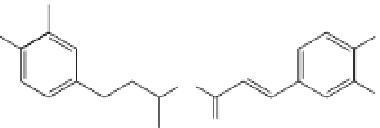Biology Reference
In-Depth Information
resistant Gram-negative bacteria was exam-
ined. Bacteria were clinical isolates from
skin, blood and/or respiratory tract infections
(
Escherichia coli, Klebsiella pneumoniae,
Proteus mirabilis, Enterobacter cloacae,
Serratia marcescens, Morganella morganii,
Acinetobacter baumannii, Pseudomonas
aeruginosa and Stenotrophomonas mal-
tophilia
) and ATCC reference strains
(
Escherichia coli
ATCC 35218 and
Escherichia coli
ATCC 25922) (Zampini
et al
.,
2005). The selected bacteria are causal agents
of infections in humans. The antibacterial
activity was determined using the agar disc
diffusion method (12.5-400 mg/disc); the
minimal inhibitory concentration (MIC)
was determined by serial agar macrodilu-
tion and broth microdilution assays (6.25-
400 mg/ml) (NCCLS, 2002). MIC was defined
as the lowest concentration of soluble prin-
ciples or 2¢,4¢-dihydroxychalcone at which
no colony was observed after incubation.
The minimal bactericidal concentration
was determined for concentrations of the
extract or the purified substance at which
99.9 % of bacteria were killed.
Components of the ethanol extract were
further separated by solvent extraction
(ethyl ether) and column chromatography
(Pederiva
et al
., 1975; Zampini
et al
., 2005),
yielding, among others, a known compound
(2¢,4¢-dihydroxychalcone) with a strong
antibacterial activity (0.10-1.00 mg/ml)
against
P. mirabilis, E. cloacae, S. marces-
cens, M. morganii, A. baumannii, P. aerugi-
nosa
and
S. maltophilia
. These values are
lower than that obtained for imipenem
(0.25-16 g/ml), one of the most effective
antibiotics against Gram-negative bacteria.
Consequently,
Z. punctata
constitutes a
good source of antibacterial compounds
against Gram-negative resistant and multi-
resistant species. Many pharmacological
properties attributed to chalcones would be
ascribed to the ketone function of the three-
carbon chain with an a,b-unsaturation.
Substitutions on the A ring are most often
identical to those of other flavonoids (2¢, 3¢,
6¢). (This is equivalent to the 5- and 7-
positions of the oxygen of the pyran ring.
The numbering is reversed so that the
benzophenone carbons are identified by
R
4
3
2
1
5
HO
OH
6
4
8
8
9
9
O
5
OH
3
1
7
2
6
7
O
10
Fig. 12.4.
Chemical structure of 1-methyl-3-
(4
¢
-hydroxyphenyl)-propyl caffeate (R = H) and
1-methyl-3-(3
¢
,4
¢
-dihydroxyphenyl)-propyl caffeate
(R = OH), according to Svetaz
et al.
(2004).
R
5''
OH
HO
2'''
6''
2
2
O
1
1
5'''
OH
6'''
3
2''
3
O
CH
3
Fig. 12.5.
Chemical structure of the synthetic
propyl caffeates: 1-methyl-3-(4
¢
-hydroxyphenyl)-
propyl caffeate (R = H) and 1-methyl-3-(3
¢
,4
¢
-
dihydroxyphenyl)-propyl caffeate (R = OH),
according to Ramachandra and Subbaraju (2006).
12.4 Bioactivities and
Pharmacological Applications
12.4.1
Antibacterial activity
For thousands of years mankind has learnt
about the benefits of plant use to alleviate or
cure illnesses. The development of drug
resistance and the appearance of undesir-
able side effects of certain antibiotics
(Davies, 1994; Poole, 2001; WHO publica-
tion, 2001) have led to the search for new
antimicrobial agents, mainly among plant
extracts, in order to find new chemical
structures to overcome the aforementioned
disadvantages. Components of plants with
antibacterial properties in general attack
Gram-positive bacteria, whereas only some
of them are active on Gram negative strains
(Herrera
et al
., 1996; Meng
et al
., 2000;
Scrinivasan
et al
., 2001).
The antibacterial effect of the ethanol
extract of
Z. punctata
aerial parts and of
2¢,4¢-dihydroxychalcone isolated from the
same source on the growth of antibiotic-


Search WWH ::

Custom Search